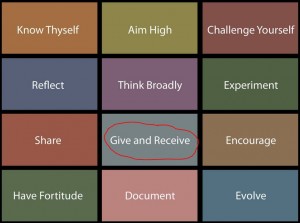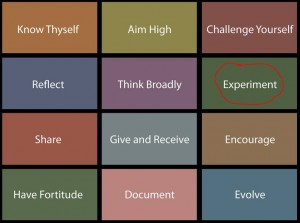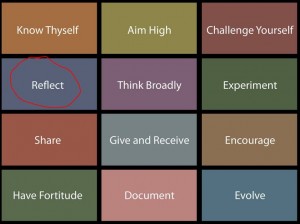What does it all mean?
Traditional
Modern
Art
Lately, I feel like I am being bombarded by the differences in types of quiltmaking. This post is my attempt to puzzle out the differences.
All of the above words evoke something in each of our minds related to quiltmaking. Each of them probably evokes something different. Language is important, because it is a mode of communication and if the words above evoke something different in each of our minds then communication is breaking down.
I would add to this, already confusing, list:
Classic
Contemporary
Fresh
All this means that I really think we, as quiltmakers, are not communicating clearly about what we do. Think about what a “traditional” quilt means to you. How would you describe a “traditional” quilt? Calico fabrics? Certain designs?
How would you describe a “Modern” quilt. Is there any overlap between “Traditional” and “Modern”?
This conversation really started with “Art” quilts. I remember the conversation being hot and heavy in the early-mid 1990s. I remember long essays about art vs. craft, art quilts vs. traditional quilts when the Internet was young and we could find people with whom to have such conversations. Modern quilts, labeled and followed, did not exist then.
While TFQ was living near me for 5 months this year, we had many discussions about quiltmaking language. She is a language person, so these types of conversations are fun, but tax my brain. I have to be precise and clear. It is good for me. Some of what I am writing comes from those conversations.
I am concerned about the assumptions that are surrounding every day language in the quiltmaking community. I don’t think it is always relevant and I think the stereotypes brought to mind when this language is used can be harmful, not only to the community, but also to people’s feelings. What do we gain by using these distinctions?
Traditional: I don’t know if there is a distinct definition of a “traditional” quilt. Does a “traditional” quilt use “traditional” blocks? I have seen “Modern” quilts made from 9 patch blocks, so are they really “traditional” quilts?
Art: What is an ‘art’ quilt? Is it a “traditional” quilt made with hand dyed fabrics? Is it a quilt of a tree where you know it is a tree and not the Pine Tree block? Is realism included? Painting? Inks? Crazy free motion quilting? Couching? Embroidery? Embellishment?
I realize that humans seem to have a need to segregate themselves into exclusive groups and that may be the distinction.
Traditional, in Random House Webster’s College Dictionary (1999), is defined as 1. of or pertaining to tradition; 2. handed down by tradition; 3. in accordance with tradition. Tradition is defined as “the handing down of statements, beliefs, legends, customs, etc., from generation to generation, esp. by word of mouth or by practice.” It is also defined as “… a long-established or inherited way of thinking or acting.” This definition doesn’t say anything about design or fabric type.
Modern, in that same resource, is defined as “of or pertaining to present and recent time. 2. characteristic of present and recent time; contemporary.” From the Modern Quilt Guild website, they define Modern quiltmaking as:
“Modern quilts and quilters:
- Make primarily functional rather than decorative quilts
- Use asymmetry in quilt design
- Rely less on repetition and on the interaction of quilt block motifs
- Contain reinterpreted traditional blocks
- Embrace simplicity and minimalism
- Utilize alternative block structures or lack of visible block structure
- Incorporate increased use of negative space
- Are inspired by modern art and architecture
- Frequently use improvisational piecing
- Contain bold colors, on trend color combinations and graphic prints
- Often use gray and white as neutrals
- Reflect an increased use of solid fabrics
- Focus on finishing quilts on home sewing machines
Modern quilting has its roots in rebellion, in our desire to do something different, but simultaneously its feet are firmly planted in the field of tradition. Modern quilting is our response to what has come before. We are quilters first, modern quilters second. There are however, characteristics that set modern quilters apart from our traditional and art quilting friends.
Modern quilters are a diverse group of woman and men, young and old, experienced and novice, yet each of us feels the need to differentiate ourselves as modern quilters by how we work, the fabrics we choose, and the aesthetic of our quilts. We create in a way that supports our individual creative needs and our lifestyle preferences.” (from Modern quilt guild website About Us page)
From the dictionary definition, I could infer that any quilt made this year is modern. The definition says “of or pertaining to present and recent time, ” so isn’t that what it means?
The above Modern Quilt Guild definition is very helpful to me for a number of reasons, but mostly because it tells me that some of the definitions and assumptions about what a modern quilt is, which I have heard on the web and in social media, are untrue. There seems to be “information” floating around that is suffering from the “Telephone Game” syndrome. The information is read, extrapolated out from the original source, morphed and then disseminated incorrectly. The Modern Quilt Guild website is pretty clear about what modern quilts are. There is no mention of age, time of guild meetings. This makes me think that the advent of the Modern Quilt Guild became popular, because people were given permission to start guilds of their own; guilds that fit their needs and aesthetic sensibilities. The attitude of “we did it, so can you.”
I do think “modern” quilts exist. I just don’t think that all quilts being made by members of the modern quilt movement are modern. I think Jackie of Tall Grass Prairie Studio’s Babyscapes work in progress is Modern. Perhaps there is an offshoot or subsidiary of Modern quiltmaking called fresh or contemporary quiltmaking where the newer, lighter fabrics are used in classic patterns? Perhaps the intersection of Modern and Traditional is Classic, Fresh?
Yes, I would add a category for Classic patterns. Classics are like the little black dress of quiltmaking: 9 Patches come to mind, as well as 4 patches. They are both elements of a quilt in and of themselves, as well units in larger designs.
Art, again from the same resource noted above, is defined as “… the quality, production, expression, or realm of what is beautiful or of more than ordinary significance. 2. the class of objects subject to aesthetic criteria, as paintings, sculptures, or drawings. … 7. the principles or methods governing any craft or branch of learning…9. skill conducting any human activity. …” The definitions for art go on and on (and I have omitted some, but you can look up the long list yourself). None of them say you have to have things hanging off of your quilt or that you have to throw paint at your quilt and use only hand dyed fabrics for your piece to make it an art quilt. SAQA defines an art quilt as “a creative visual work that is layered and stitched or that references this form of stitched layered structure.”
I just think that the language could be improved. Really, I don’t think we absolutely need categories. The important question is “does this quilt (or quilt-like structure) appeal to me? Am I being playful and having fun?
Instead of “traditional”, I prefer the term classic. Classic blocks, to me, are blocks that have been around for awhile. They might have first shown up in Godey’s Ladies Book, in a newspaper in the 1930s, or in a farm journal in the 1910s. You might now find them in the Encyclopedia of Pieced Quilt Patterns by Barbara Brackman or in Jinny Beyer’s The Quilter’s Album of Patchwork Patterns (2009) book. They are also blocks that conform to the accepted structure we know as blocks – usually squares (though hexagons and Double Wedding Ring come to mind as well) with shapes making up that structure. This means that they don’t have to come from Godey’s Ladies Book, but could have been designed by Jinny Beyer or another designer more recently.
Classic quilts are an offshoot of Classic blocks and cannot be defined absolutely in my mind. Two different quiltmakers could take the same fabric and the block pattern and make very different pieces. Designs can diverge in completely different directions even if everything else remains the same. Quilts must, then, be categorized even further, if categorization is necessary, into a taxonomy that includes fabric and designers, such as Civil War, 1930s, calico, etc. I also think such a categorization would have to have multiple layers to accommodate a variety of choices:
- Block choice: 9 Patch
- Fabric Choice: Civil War reproduction or Amy Butler Soul Blossoms?
- Sewing style: straight or wonky
Each of the above categorizations is an example of how a quilt could be defined more clearly. The key would be what element to start with: block design or fabric? Sewing style or quilt layout?
Contemporary or Classic Modern may more exactly describe quilts using fresh, new fabrics such as Bonnie and Camille fabrics, large scale prints or dots combined with classic block designs.
Mark Lipinski said, in his May 9, 2012 podcast that making quilts is about doing what you love. I think is true. Let’s make quilts in the style that makes us happy, welcome other people into the quiltmaking fold, enjoy their work even if we do not want to make a duplicate, and not judge.





